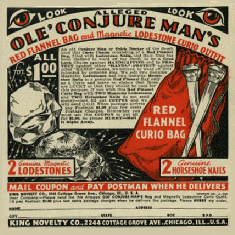GOT MY MOJO WORKING
Etta James
 So what is a mojo? It is, in short, the staple amulet of African-American hoodoo practice, a flannel bag containing one or more magical items. The word is thought by some to be a corruption of the English word "magic" but it more likely is related to the West African word "mojuba," meaning a prayer of praise and homage. It is a "prayer in a bag" -- a spell you can carry.
So what is a mojo? It is, in short, the staple amulet of African-American hoodoo practice, a flannel bag containing one or more magical items. The word is thought by some to be a corruption of the English word "magic" but it more likely is related to the West African word "mojuba," meaning a prayer of praise and homage. It is a "prayer in a bag" -- a spell you can carry.
Alternaive American names for the mojo bag include hand, mojo hand, conjure hand, lucky hand, conjure bag, trick bag, root bag, toby, jomo, and gris-gris bag. In the Memphis region, a special kind of mojo, worn only by women, is called a nation sack. A mojo used for divination, somehwat like a pendulum, is called a Jack, Jack bag, or Jack ball.
The word "hand" in this context means a combination of ingredients. The term may derive from the use of finger and hand bones of the dead in mojo bags made for various purposes, from the use of a rare orchid root called Lucky Hand root as an ingredient in mojo bags for gamblers, or by an analogy between the mixed ingredients in the bag and the several cards that make up a "hand" in card games.
Although most "Southern Style" conjure bags are made of red flannel, some root doctors favour the colour-symbolism employed in hoodoo style candle-burning magic and thus use green flannel for a money mojo, white flannel for a baby-blessing mojo, red flannel for a love mojo, pale blue flannel for a peaceful home mojo, and so forth. Leather bags are also seen, but far less frequently than flannel; they are associated with West Indian obeah, another form of folk magic closely related to African-American hoodoo.
Mojos made for an individual are usually carried on the person, always out of sight. They are very rarely worn on a string around the neck, fairly commonly pinned inside a woman's brassiere, and much more commonly pinned to the clothes below the waist or caried in a pants pocket. Those who make conjure bags to carry as love spells sometimes specify that the mojo be worn next to the skin. Mojos intended to purify or protect a location are generally placed near the door, hidden in such a way that they cannot be seen by strangers.
Etta James
 So what is a mojo? It is, in short, the staple amulet of African-American hoodoo practice, a flannel bag containing one or more magical items. The word is thought by some to be a corruption of the English word "magic" but it more likely is related to the West African word "mojuba," meaning a prayer of praise and homage. It is a "prayer in a bag" -- a spell you can carry.
So what is a mojo? It is, in short, the staple amulet of African-American hoodoo practice, a flannel bag containing one or more magical items. The word is thought by some to be a corruption of the English word "magic" but it more likely is related to the West African word "mojuba," meaning a prayer of praise and homage. It is a "prayer in a bag" -- a spell you can carry.Alternaive American names for the mojo bag include hand, mojo hand, conjure hand, lucky hand, conjure bag, trick bag, root bag, toby, jomo, and gris-gris bag. In the Memphis region, a special kind of mojo, worn only by women, is called a nation sack. A mojo used for divination, somehwat like a pendulum, is called a Jack, Jack bag, or Jack ball.
The word "hand" in this context means a combination of ingredients. The term may derive from the use of finger and hand bones of the dead in mojo bags made for various purposes, from the use of a rare orchid root called Lucky Hand root as an ingredient in mojo bags for gamblers, or by an analogy between the mixed ingredients in the bag and the several cards that make up a "hand" in card games.
Although most "Southern Style" conjure bags are made of red flannel, some root doctors favour the colour-symbolism employed in hoodoo style candle-burning magic and thus use green flannel for a money mojo, white flannel for a baby-blessing mojo, red flannel for a love mojo, pale blue flannel for a peaceful home mojo, and so forth. Leather bags are also seen, but far less frequently than flannel; they are associated with West Indian obeah, another form of folk magic closely related to African-American hoodoo.
Mojos made for an individual are usually carried on the person, always out of sight. They are very rarely worn on a string around the neck, fairly commonly pinned inside a woman's brassiere, and much more commonly pinned to the clothes below the waist or caried in a pants pocket. Those who make conjure bags to carry as love spells sometimes specify that the mojo be worn next to the skin. Mojos intended to purify or protect a location are generally placed near the door, hidden in such a way that they cannot be seen by strangers.
Fonte: Hoodoo in Theory and in Practice,Catherine Yronwode


3 Comments:
Muito fixe, obrigada!
De nada,oh Sibila da Calcada da Tapada
êta! Etta James! thanks much :)
Enviar um comentário
<< Home